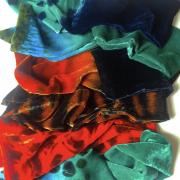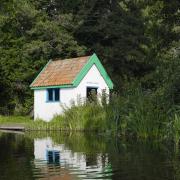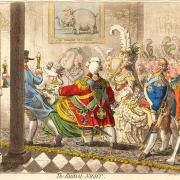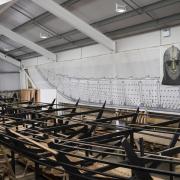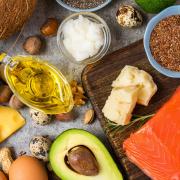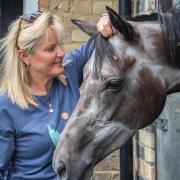There's a new crop growing at Wakelyns, the pioneering agroforestry farm at Fressingfield.
In the alleys between the strips of fruit trees, alongside lentils and cereals, and seasonal organic vegetables, Claire O’Sullivan and Kitty Wilson Brown are harvesting hemp, assisted by a small army of volunteers who have joined them for a late summer hemp harvest retreat.
There's a lot of chatter and a lot of laughter among the group of individuals drawn to the event by their shared interests in the environment, climate change and fashion. They've come long to learn about the special qualities of hemp and how it could play a part in a more sustainable future for land use and textile production.
It's hard work. Hemp – the industrial variety grown for its woody fibre and not to be confused with the sort grown for marijuana – takes some handling. It can grow up to five metres tall, its many clusters of leaves and flowers sprouting from long, cane-like stems; harvesting and processing requires considerable physical effort. But Claire and Kitty are enjoying every moment, buoyed by an infectious energy and enthusiasm for their project.

Contemporary Hempery, is the latest project to be hosted at David Wolfe's 23-hectare farm, where annual crops are integrated with trees and other perennial plants. The pair met in Cornwall when Claire, originally from Norfolk, was living there. She is a studio jeweller, with an MA in entrepreneurship for creative practice, while Kitty is a textile artist and weaver who graduated with a BA at Chelsea College of Art, UAL, in June 2020.
Kitty still lives in Cornwall, but in 2020 Claire decided to move back to her native East Anglia, settling in Fressingfield. The women stayed in touch and around Christmas 2021, Claire mentioned a book she'd been reading about pre-mechanised farming and hemp as an important crop, particularly in East Anglia. The seeds of an idea where sown.
With a focus on sustainability, she was drawn to the possibilities of producing fabric from a crop grown in English soil – literally 'grow your own clothes'. Not long after, while buying bread and vegetables, Claire came across Wakelyns which seemed like the perfect place to try growing hemp. She got talking to David Wolfe and Contemporary Hempery was born.

Wakelyns was established in 1994 as an experimental farm by the late professor Martin Wolfe and his wife, Ann, to test and develop organic agroforesty methods. An agricultural scientist working for the government, he was looking for a retirement project and found it in Wakelyns.
Their aim was to increase diversity in fields and between fields, which would increase overall yields and ensure the farm was better able to cope with variations in climate, was more resistant to pests and diseases, and less dependent on fertiliser from outside the farm. And do it on a scale never tried before. Lines of mixed fruit trees were planted, running north to south for maximum sunshine. In the alleys between, grow various crops on rotation.
Almost 30 years on, Wakelyns is run by Martin's son David, and his wife, Amanda, who are carrying on what Ann and Martin started. They have added other enterprises to the mix, hosting RealVeg, a community supported vegetable growing enterprise, and Henrietta Inman's on-site Wakelyn's Bakery, which uses the farm's fruit and produce to add value, create employment, and produce wholesome food.

Contemporary Hempery is an exciting and interesting new arrival, although, in fact, growing hemp in Suffolk is nothing new, as Claire and Kitty were to discover when they embarked on a rapid and steep learning curve between May 2022, when the first seeds went into the ground, and the following August when they harvested their first crop.
Research told them that they were growing hemp in what was once the heartland of a thriving local industry between Eye and Beccles. Who knows when hemp was first grown in Britain; Claire's research shows the earliest mention of its use here is 373 BC, but it may have been brought to Britain from Asia as early as 800 BC. The Romans used it here, and Anglo-Saxons made cloth from hemp – hempenspun.
The golden age was the 16th century. So important was hemp for producing durable, rot-resistant sails, rope and nets for his navy that, in 1533, Henry VIII made hemp cultivation compulsory by law. For every 60 acres, farmers had to grow about 1/4 acre of flax or hemp, or be fined.

In East Anglia, the industrial heartland was north Suffolk and south Norfolk, particularly the Waveney valley. The main markets were at Beccles, Diss, East Harling, and Halesworth, Bury St Edmunds and Woodbridge.
It was a cottage industry, labour-intensive with complex processing. By the time production peaked in the 18th century the Waveney Valley alone produced one eighth of the country's output. Decline came soon after 1800, mainly due to competition from much cheaper jute and cotton, with a huge impact on poorer people who relied on it for employment.
By the 1850s the hemp industry had almost disappeared, but the industry's legacy can be found throughout the region, in place names like Hempnell and Hempstead, and fields known as 'Hemplands'. Names like 'Rettery Cottages' reflect the language of hemp-making. The harvested plants have to be retted (soaked); 'Bleach Green’ refers to where linen was laid out in the sunlight; 'Heckfield Green' where the heckling, or combing, was carried out.
According to the British Hemp Alliance, about 810 hectares of hemp are grown in Britain today, and now Contemporary Hempery is part of that. A complication of growing hemp is that it comes from the same plant species as marijuana, Cannabis Sativa. Industrial hemp has only trace amounts of the psychoactive chemical THC and cannot induce a 'high', but it is strictly controlled and there are limitations on how the plant can be processed. The leaves and flowers, for example, which are used in some countries to make CBD, must be destroyed in Britain once they are separated from the stem.


The first step for Claire and Kitty was to obtain a licence from the Home Office. Seed had to be imported from the EU; Claire and Kitty got theirs from Hemp.it, the fourth biggest growers in France and they grow Futura 75, a variety with especially long fibres. Then it was a case of contacting anyone they could track down who would share information about growing a processing hemp to make fabric.
People, says Claire, were incredibly helpful. 'Either through craft or the textile industry people have wanted to help us and show us how to do it. It's been so encouraging.' Another resource was old documents and drawings showing people hard at work using traditional tools, which they replicated.
Hemp grows quickly and strongly in all soils (Wakelyns is on clay), just one of its several advantages. According to the British Hemp Alliance, it's one of the most versatile and prolific tools available for tackling environmental challenges. It bio-remediates contaminated soil, improves soil structure and nutrient levels, and can lead to greater yields in follow-on crops, such as wheat. It’s also one of the most effective CO2 offsets.

As a sustainable raw material, says the BHA, hemp can make more than 10,000 environmentally responsible and bio-degradable products, including plastics, fuel and fibre. It also grows without the need for pesticides or herbicides, and needs minimal water. 'Last year,' says Claire, 'it was extremely hot with little rain and our first crop just grew and grew.'
They organised a community day for their first harvest, and then got on with processing, learning on the job. To obtain the fibre from hemp the stalks have to be retted – soaked in a pit – dried, then bashed and shaken to completely separate the woody portion and release the long, fairly straight fibre. It must then be heckled, a process which straightens and splits the fibre ready for spinning.
With enough work, hemp can be processed into fabric as fine as the finest linen. 'This is the extraordinary versatility of the fibre,' says Claire. 'It makes both massively strong maritime rope and gossamer fine fabrics. However, currently there's no mechanical processing and there are no spinning mills in the UK that do plant fibre spinning.' Her answer was to organise a hand-spinning day. 'We put the word out and we had 30 spinners here in my home. It was brilliant.'
But they still only produced a small amount of yarn and if Claire and Kitty are to realise their vision they need to find a way to produce enough hemp yarn to weave into fabric – a producer with the right machinery to spin and weave plant fibre.

This year's hemp harvest retreat – a chilled long weekend with music, food, dancing, talks and demonstrations, and some hard harvesting work thrown in – was the next step along the way to creating high quality, sustainable, beautiful clothes from a product grow right here in Suffolk. Showing people the process and keeping it alive is vital. Claire and Kitty are passionate and serious about their project and give talks and demonstrations about Contemporary Hempery whenever they can.
'We want to elevate hemp and natural fibres to a new level, creating beautiful fabric from UK-produced regenerative hemp,' says Claire. With that in mind she believes there's potential to collaborate with a British designer or brand. After all, they've promised David Wolfe they'll have Wakelyns-grown clothes on the catwalk at London Fashion Week within five years.





